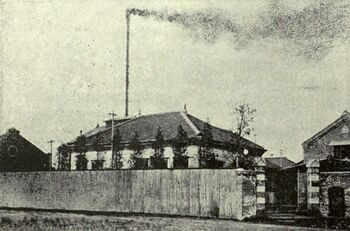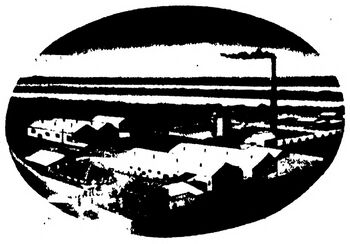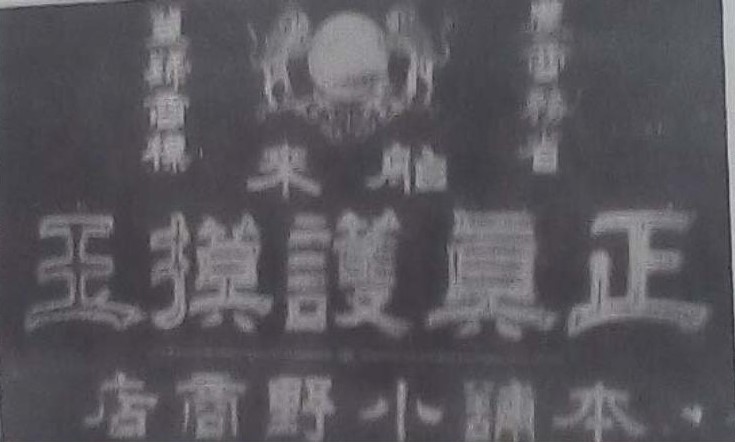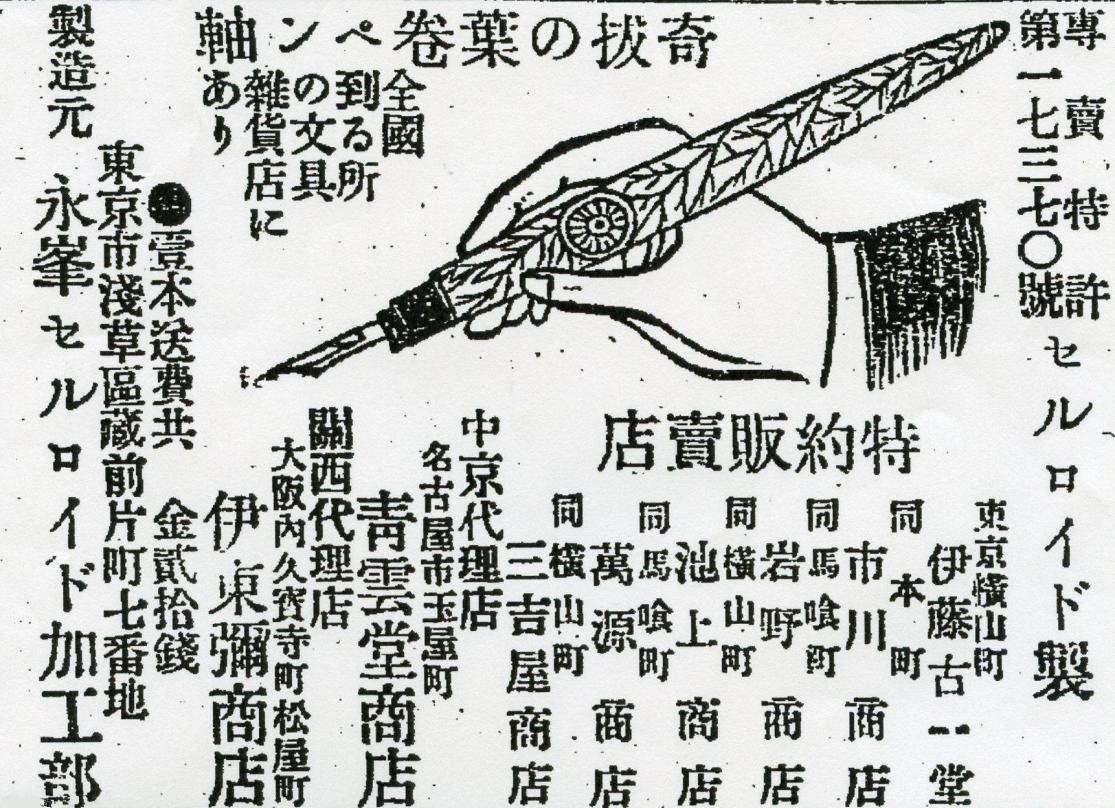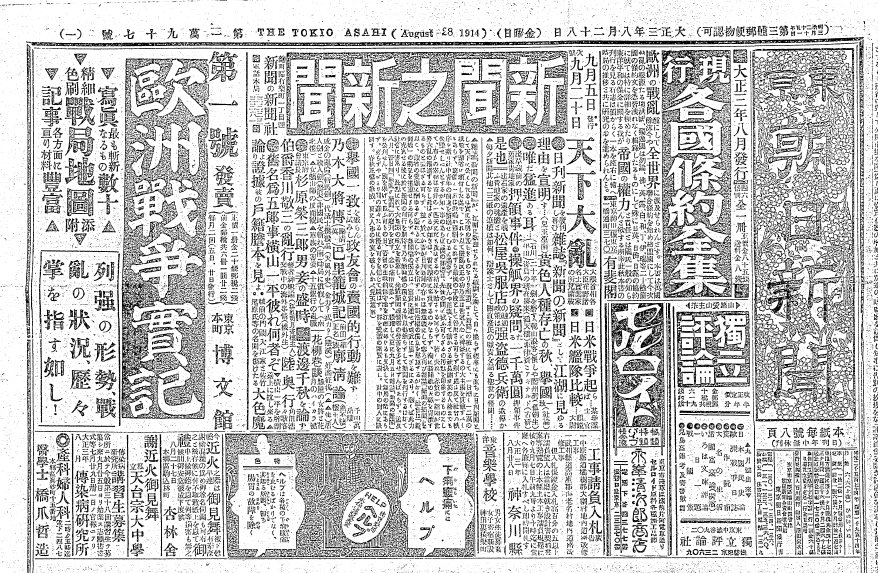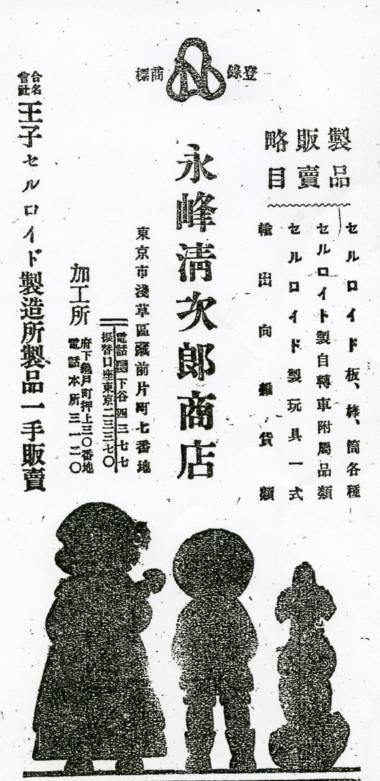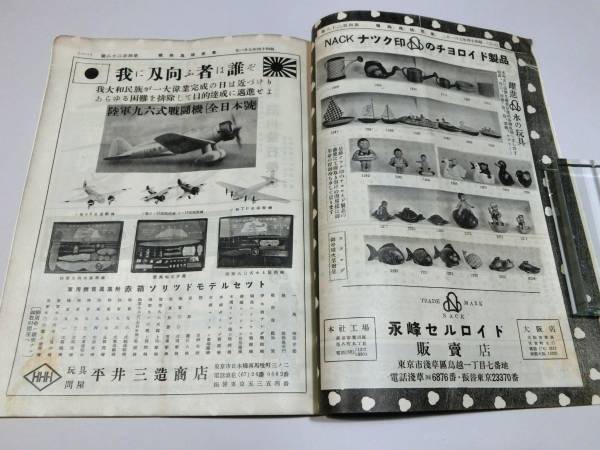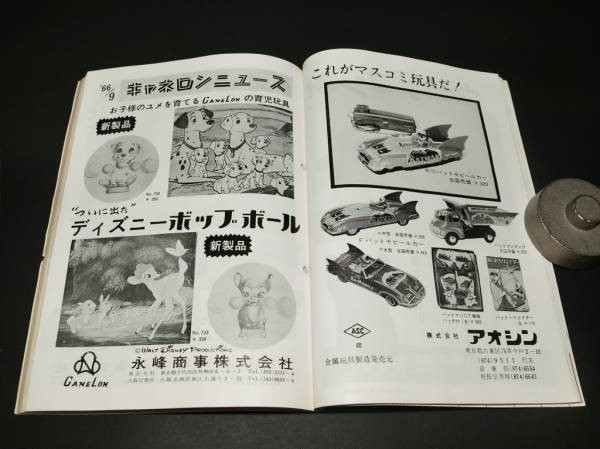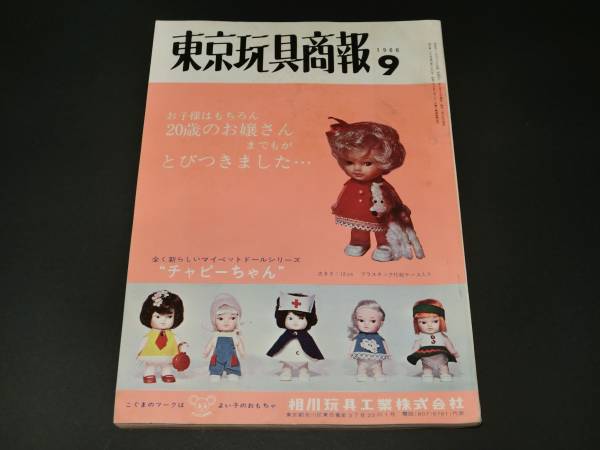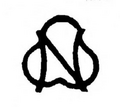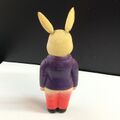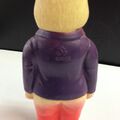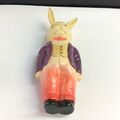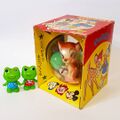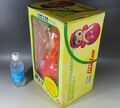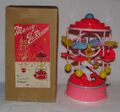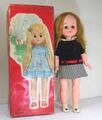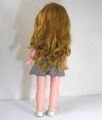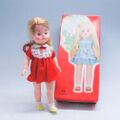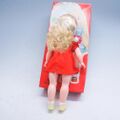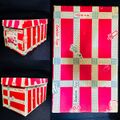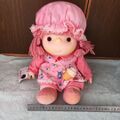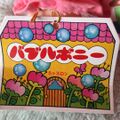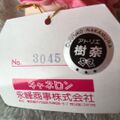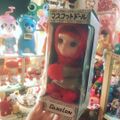Difference between revisions of "Canelon Toys"
From Sega Retro
m (→History: This 2023 article from the ameblo.jp website features some photos taken at the Nagamine plant located in the Ogu area of Arakawa, which were published in the May 1936 issue of the women's magazine Fujin Kōron (https://en.wikipedia.org/wiki/Fujin_Kōron). Seisaburo Nagamine was the President of the company at the time...) |
|||
| (5 intermediate revisions by 2 users not shown) | |||
| Line 1: | Line 1: | ||
{{CompanyBob | {{CompanyBob | ||
| logo=Canelon Toys Logo.png | | logo=Canelon Toys Logo.png | ||
| − | | founded=1884{{ | + | | founded=1884{{fileref|Glimpses-of-East-Asia-Book-JP-1935-Volume-18-page-54.jpg}}{{fileref|History of Japanese Celluloid Industry JP Part 2.pdf|page=9}} |
| defunct= | | defunct= | ||
| mergedwith=Maruzen Co. Ltd (株式会社丸善) | | mergedwith=Maruzen Co. Ltd (株式会社丸善) | ||
| Line 8: | Line 8: | ||
| headquarters2=Honjō, Saitama Prefecture, Japan | | headquarters2=Honjō, Saitama Prefecture, Japan | ||
}} | }} | ||
| − | {{stub}}'''{{PAGENAME}}''' (株式会社キャネロン, Kabushiki Gaisha Kyaneron), currently Canelon Chemicals Co. Ltd{{ref|http://www.maruzen.net/canelon/index.html}} (キャネロン化工株式会社, Kyaneron Kakō Kabushiki Gaisha), a division of Maruzen Co. Ltd{{ref|http://www.maruzen.net/index.html}} (株式会社丸善, Kabushiki Gaisha Maruzen), is a plastic products{{ | + | {{stub}}'''{{PAGENAME}}''' (株式会社キャネロン, Kabushiki Gaisha Kyaneron), currently Canelon Chemicals Co. Ltd{{ref|http://www.maruzen.net/canelon/index.html}} (キャネロン化工株式会社, Kyaneron Kakō Kabushiki Gaisha), a division of Maruzen Co. Ltd{{ref|http://www.maruzen.net/index.html}} (株式会社丸善, Kabushiki Gaisha Maruzen), is a plastic products{{fileref|Da23d02a759ca3fc58eff4f28ce4c8f96b00fe61.jpg}} manufacturing company (plastic containers, trays, packaging and growing systems for the horticultural and food industries) and former toy manufacturer{{fileref|CanelonToys Box.jpg}}{{fileref| |
CanelonToys Doll.jpg}}{{fileref|CanelonToys Baby Toy.jpg}}{{fileref|CanelonToys Piano.jpg}} based in [[wikipedia:Honjō, Saitama|Honjō]], Japan. | CanelonToys Doll.jpg}}{{fileref|CanelonToys Baby Toy.jpg}}{{fileref|CanelonToys Piano.jpg}} based in [[wikipedia:Honjō, Saitama|Honjō]], Japan. | ||
[[File:CanelonChemicals (2012).jpg|thumb|350px|right|Canelon Chemicals Co. Ltd. (キャネロン化工株式会社) in [[wikipedia:Honjō, Saitama|Honjō]], Japan, as seen in 2012]] | [[File:CanelonChemicals (2012).jpg|thumb|350px|right|Canelon Chemicals Co. Ltd. (キャネロン化工株式会社) in [[wikipedia:Honjō, Saitama|Honjō]], Japan, as seen in 2012]] | ||
| Line 15: | Line 15: | ||
[[File:NagamineSeijiroShoten Headquarters (1917).jpg|thumb|350px|right|Nagamine Seijiro Shoten (永峰清次郎商店) headquarters in the Kuramae district of [[wikipedia:Asakusa|Asakusa]], Tokyo, as seen in 1917{{fileref|Japan in the Taisho Era Book JP 1917 (by Nishizawa, Iwata).pdf|page=725}}{{fileref|Japan in the Taisho Era Book JP 1917 (by Nishizawa, Iwata).pdf|page=726}}]] | [[File:NagamineSeijiroShoten Headquarters (1917).jpg|thumb|350px|right|Nagamine Seijiro Shoten (永峰清次郎商店) headquarters in the Kuramae district of [[wikipedia:Asakusa|Asakusa]], Tokyo, as seen in 1917{{fileref|Japan in the Taisho Era Book JP 1917 (by Nishizawa, Iwata).pdf|page=725}}{{fileref|Japan in the Taisho Era Book JP 1917 (by Nishizawa, Iwata).pdf|page=726}}]] | ||
[[File:NagamineCelluloidIndustryCoLtd Headquarters (1938).jpg|thumb|350px|right|Nagamine Celluloid Industry Co. Ltd (永峰セルロイド工業株式会社) headquarters in the Torigoe district of [[wikipedia:Asakusa|Asakusa]], Tokyo, as seen in 1938{{fileref|The Indo-Japanese Business Directory 1938-1939 Book JP (by Nakaya Misuma Company Limited).pdf|page=211}}{{fileref|The Indo-Japanese Business Directory 1938-1939 Book JP (by Nakaya Misuma Company Limited).pdf|page=244}}]] | [[File:NagamineCelluloidIndustryCoLtd Headquarters (1938).jpg|thumb|350px|right|Nagamine Celluloid Industry Co. Ltd (永峰セルロイド工業株式会社) headquarters in the Torigoe district of [[wikipedia:Asakusa|Asakusa]], Tokyo, as seen in 1938{{fileref|The Indo-Japanese Business Directory 1938-1939 Book JP (by Nakaya Misuma Company Limited).pdf|page=211}}{{fileref|The Indo-Japanese Business Directory 1938-1939 Book JP (by Nakaya Misuma Company Limited).pdf|page=244}}]] | ||
| − | The history of the company can be traced back to the [[wikipedia:Meiji (era)|Meiji era]]{{fileref|History of Japanese Celluloid Industry JP Part 2.pdf|page=9}}, when Japanese entrepreneur and pioneer of the Japanese celluloid industry{{fileref|TheChemistandDruggist UK 1920-06-26.pdf|page=204}} Seijiro Nagamine{{fileref|Japan and Her Exhibits at the Panama-Pacific International Exhibition Book JP 1915 (by Hakurankwai Kyokwai, Tokyo).pdf|page=282}}{{fileref|Japan and Her Exhibits at the Panama-Pacific International Exhibition Book JP 1915 (by Hakurankwai Kyokwai, Tokyo).pdf|page=466}} (永峰清次郎{{fileref|Celluloid Library Memoir House of Yokohama; Conference Osaka 2008.pdf|page=18}}, Nagamine Seijiro), an [[wikipedia:Edo period|Edo]]-style [[wikipedia:tortoiseshell|tortoiseshell]] craftsman{{ref|http://archive.vn/UFo7E}}{{ref|http://archive.vn/9HR9l}} who had just started production of celluloid combs, manufactured{{fileref|Yokohama Port and Celluloid Toys JP Research Report (by Kazuhiko Matsuo).pdf|page=6}}{{fileref|Yokohama Port and Celluloid Toys JP Research Report (by Kazuhiko Matsuo).pdf|page=7}}{{ref|https://web.archive.org/web/20190531092608/http://www.celluloidhouse.com/salon35.htm}} celluloid [https://archive.fo/DJhhu/04d1560852b50640184ab85be9f5e2cd1c259a7b.jpg blow ball pipes] known as [https://archive.vn/zIEdY ''"Fukiage balls"'' (吹き上げ玉, Fukiage-dama) in 1894]{{fileref|Celluloid Library Memoir House of Yokohama; Conference Osaka 2008.pdf|page=21}}{{ref|https://archive.ph/P5jpN|2=https://www.google.pt/search?q=永峰清次郎+吹上玉&hl=pt-PT&biw=1366&bih=625&tbm=bks&sxsrf=ALeKk01EqPbirL-YCYQyHn9fhs1cvC6pig:1623216618139&ei=6lHAYMT8B82mafD4nuAB&oq=永峰清次郎+吹上玉&gs_l=}}, the first celluloid toys in the history of Japan, produced in his workshop called Nagamine Seijiro Shoten (永峰清次郎商店, '''lit.''' Seijiro Nagamine Store) established in 1884, a business that he | + | The history of the company can be traced back to the [[wikipedia:Meiji (era)|Meiji era]]{{fileref|History of Japanese Celluloid Industry JP Part 2.pdf|page=9}}, when Japanese entrepreneur and pioneer of the Japanese celluloid industry{{fileref|TheChemistandDruggist UK 1920-06-26.pdf|page=204}} Seijiro Nagamine{{fileref|Japan and Her Exhibits at the Panama-Pacific International Exhibition Book JP 1915 (by Hakurankwai Kyokwai, Tokyo).pdf|page=282}}{{fileref|Japan and Her Exhibits at the Panama-Pacific International Exhibition Book JP 1915 (by Hakurankwai Kyokwai, Tokyo).pdf|page=466}} (永峰清次郎{{fileref|Celluloid Library Memoir House of Yokohama; Conference Osaka 2008.pdf|page=18}}, Nagamine Seijiro), an [[wikipedia:Edo period|Edo]]-style [[wikipedia:tortoiseshell|tortoiseshell]] craftsman{{ref|http://archive.vn/UFo7E|2=http://www.manekineko-k.com/users/other/coast/blog/?p=1356}}{{ref|http://archive.vn/9HR9l|https://www.culture.city.taito.lg.jp/bunkatanbou/craft/craftsmen/english/page_08.html}} who had just started production of celluloid combs, manufactured{{fileref|Yokohama Port and Celluloid Toys JP Research Report (by Kazuhiko Matsuo).pdf|page=6}}{{fileref|Yokohama Port and Celluloid Toys JP Research Report (by Kazuhiko Matsuo).pdf|page=7}}{{ref|https://web.archive.org/web/20190531092608/http://www.celluloidhouse.com/salon35.htm}} celluloid [https://archive.fo/DJhhu/04d1560852b50640184ab85be9f5e2cd1c259a7b.jpg blow ball pipes] known as [https://archive.vn/zIEdY ''"Fukiage balls"'' (吹き上げ玉, Fukiage-dama) in 1894]{{fileref|Celluloid Library Memoir House of Yokohama; Conference Osaka 2008.pdf|page=21}}{{ref|https://archive.ph/P5jpN|2=https://www.google.pt/search?q=永峰清次郎+吹上玉&hl=pt-PT&biw=1366&bih=625&tbm=bks&sxsrf=ALeKk01EqPbirL-YCYQyHn9fhs1cvC6pig:1623216618139&ei=6lHAYMT8B82mafD4nuAB&oq=永峰清次郎+吹上玉&gs_l=}}, the first celluloid toys in the history of Japan, produced in his workshop called Nagamine Seijiro Shoten (永峰清次郎商店, '''lit.''' Seijiro Nagamine Store) established in 1884, a business that he ran with the help of his two sons Seizaburo Nagamine{{fileref|Japan in the Taisho Era Book JP 1917 (by Nishizawa, Iwata).pdf|page=726}}{{ref|https://archive.ph/i8GzN|https://ameblo.jp/akasikogorou/entry-12833255131.html}} (永峰誠三郎{{fileref|Seizaburo Nagamine, Database for Japanese Studies (Eighth Edition); Human Resources Information 1928-07-03 (by Nagoya University Graduate School of Law).pdf}}, Nagamine Seizaburo) and Kanematsu Nagamine{{fileref|Japan in the Taisho Era Book JP 1917 (by Nishizawa, Iwata).pdf|page=726}} (永峰兼松{{ref|https://web.archive.org/web/20081121204159/http://www.celluloidhouse.com/list.htm}}{{ref|http://archive.vn/kyiEI|2=https://dl.ndl.go.jp/info:ndljp/pid/3558644?tocOpened=1}}, Nagamine Kanematsu). |
| − | Three years later in 1897{{fileref|History of Japanese Celluloid Industry JP Part 2.pdf|page=9}}, [https://ja.wikipedia.org/wiki/%E5%9D%AA%E4%BA%95%E7%8E%84%E9%81%93 Gendō Tsuboi]{{ref|http://archive.vn/eAdov | + | Three years later in 1897{{fileref|History of Japanese Celluloid Industry JP Part 2.pdf|page=9}}, [https://ja.wikipedia.org/wiki/%E5%9D%AA%E4%BA%95%E7%8E%84%E9%81%93 Gendō Tsuboi]{{ref|http://archive.vn/eAdov|2=http://archive.footballjapan.co.uk/user/scripts/user/person_en.php?person_id=7}}{{fileref|GendouTsuboi.jpg}} (坪井玄道) introduced in Japan the first table tennis ball and in the next year in 1898{{fileref|History of Japanese Celluloid Industry JP Part 2.pdf|page=9}} production of table tennis balls{{ref|https://archive.vn/0mcN5|2=https://world-tt.com/ps_info/ps_report_detail.php?bn=5&pg=HEAD&page=BACK&rpcdno=1513#1513}} begins at Seijiro Nagamine's workshop which had just began exporting celluloid blow ball pipes in that year, shipping fifty dozens{{fileref|Yokohama Port and Celluloid Toys JP Research Report (by Kazuhiko Matsuo).pdf|page=7}} to [[wikipedia:Chongqing|Chongqing]] in China. |
| − | In 1911{{fileref|History of Japanese Celluloid Industry JP Part 2.pdf|page=9}}{{fileref|Celluloid Library Memoir House of Yokohama; Conference Osaka 2008.pdf|page=21}} Seijiro Nagamine invented the [[wikipedia:Blow molding|blow molding]] method of manufacturing dolls, [https://archive.vn/8ea1E which he patented in 1913]{{fileref|Celluloid Library Memoir House of Yokohama; Conference Osaka 2008.pdf|page=16}}{{ref|http://archive.ph/ZlFcb}}{{ref|http://archive.fo/01xOG}} and in 1915 Nagamine's celluloid dolls manufactured with this method were ehxibited{{ref|http://web.archive.org/web/20200215150031/https://www.daicel.com/news/2017/20171130_109.html}}{{fileref|Japan and Her Exhibits at the Panama-Pacific International Exhibition Book JP 1915 (by Hakurankwai Kyokwai, Tokyo).pdf|page=282}}{{fileref|Japan and Her Exhibits at the Panama-Pacific International Exhibition Book JP 1915 (by Hakurankwai Kyokwai, Tokyo).pdf|page=466}} for the first time outside Japan at the [[wikipedia:Panama–Pacific International Exposition|Panama–Pacific International Exposition]] held in San Francisco. | + | In 1911{{fileref|History of Japanese Celluloid Industry JP Part 2.pdf|page=9}}{{fileref|Celluloid Library Memoir House of Yokohama; Conference Osaka 2008.pdf|page=21}} Seijiro Nagamine invented the [[wikipedia:Blow molding|blow molding]] method of manufacturing dolls, [https://archive.vn/8ea1E which he patented in 1913]{{fileref|Celluloid Library Memoir House of Yokohama; Conference Osaka 2008.pdf|page=16}}{{ref|http://archive.ph/ZlFcb|https://jaa2100.org/entry/detail/055449.html}}{{ref|http://archive.fo/01xOG|http://www.celluloidhouse.com/salon17.htm}} and in 1915 Nagamine's celluloid dolls manufactured with this method were ehxibited{{ref|http://web.archive.org/web/20200215150031/https://www.daicel.com/news/2017/20171130_109.html}}{{fileref|Japan and Her Exhibits at the Panama-Pacific International Exhibition Book JP 1915 (by Hakurankwai Kyokwai, Tokyo).pdf|page=282}}{{fileref|Japan and Her Exhibits at the Panama-Pacific International Exhibition Book JP 1915 (by Hakurankwai Kyokwai, Tokyo).pdf|page=466}} for the first time outside Japan at the [[wikipedia:Panama–Pacific International Exposition|Panama–Pacific International Exposition]] held in San Francisco. |
| − | The demand for Japanese toys increased due to the outbreak of World War I a year before in 1914{{fileref|History of Japanese Celluloid Industry JP Part 2.pdf|page=9}} and in June 1918{{ref|https://web.archive.org/web/20190908192706/http://www.celluloidhouse.com/salon142.html}}{{ref|https://web.archive.org/web/20161220210124/http://www.nippra.or.jp/enkaku.html}} the Japan Celluloid Products Export and Trade Association (日本セルロイド製品同業組合連合会, Nihon Seruroido Seihin Dōgyō Kumiai Rengō-kai) was established with the permission of the Ministry of Agriculture and Commerce of Japan, for the purpose of conducting export inspections and eliminating defective products in the industry and Seijiro Nagamine who at the time had three large manufacturing plants in Tokyo Metropolis, located in the special wards of [[wikipedia:Chiyoda, Tokyo|Chiyoda]], [[wikipedia:Kōtō|Kōtō]] and [[wikipedia:Arakawa,Tokyo|Arakawa]], was appointed the representative for the Tokyo region, later changing [https://books.google.pt/books?id=9IDU-yYcXboC&pg=PA80&lpg=PA80&dq=nagamine+seruroido&source=bl&ots=ekFePClgxo&sig=ACfU3U0pBMufSssGPqo0hwS1dXFJ-C3giA&hl=pt-PT&sa=X&ved=2ahUKEwjy__Ctv9LnAhUBzhoKHUH0AOwQ6AEwC3oECAcQAQ#v=onepage&q=nagamine%20celluloid&f=false the name of the company] to [https://books.google.pt/books?id=zHRplFkIObgC&pg=PA24&lpg=PA24&dq=nagamine+celluloid+company&source=bl&ots=mb1ulPYrrx&sig=ACfU3U1KJAK2pfgq4N9HzmHIXx-9jh4qKw&hl=pt-PT&sa=X&ved=2ahUKEwjC8_PogdTnAhVlA2MBHTyGBNoQ6AEwAHoECAkQAQ#v=onepage&q=nagamine%20celluloid%20company&f=false Nagamine Celluloid Industry Co. Ltd.]{{fileref|Working Rules for Financial Statements and Pre-WW2 Financial Reporting of Japanese Industrial Firms 2008-03 (by Masayoshi Noguchi and Michiyasu Nakajima).pdf|page=10}}{{fileref|Working Rules for Financial Statements and Pre-WW2 Financial Reporting of Japanese Industrial Firms 2008-03 (by Masayoshi Noguchi and Michiyasu Nakajima).pdf|page=14}}{{fileref|Working Rules for Financial Statements and Pre-WW2 Financial Reporting of Japanese Industrial Firms 2008-03 (by Masayoshi Noguchi and Michiyasu Nakajima).pdf|page=25}}{{fileref|The Japan Year Book 1920-1921 Book JP (by Yoshitaro Takenobu).pdf|page=687}}{{fileref|The Japan Year Book 1923 Book JP (by Yoshitaro Takenobu).pdf|page=656}}{{fileref|The Social Democratic Movement in Prewar Japan Book US 1966 (by George Oakley Totten).pdf|page=163}} (永峰セルロイド工業株式会社{{ | + | The demand for Japanese toys increased due to the outbreak of World War I a year before in 1914{{fileref|History of Japanese Celluloid Industry JP Part 2.pdf|page=9}} and in June 1918{{ref|https://web.archive.org/web/20190908192706/http://www.celluloidhouse.com/salon142.html}}{{ref|https://web.archive.org/web/20161220210124/http://www.nippra.or.jp/enkaku.html}} the Japan Celluloid Products Export and Trade Association (日本セルロイド製品同業組合連合会, Nihon Seruroido Seihin Dōgyō Kumiai Rengō-kai) was established with the permission of the Ministry of Agriculture and Commerce of Japan, for the purpose of conducting export inspections and eliminating defective products in the industry and Seijiro Nagamine who at the time had three large manufacturing plants in Tokyo Metropolis, located in the special wards of [[wikipedia:Chiyoda, Tokyo|Chiyoda]], [[wikipedia:Kōtō|Kōtō]] and [[wikipedia:Arakawa,Tokyo|Arakawa]], was appointed the representative for the Tokyo region, later changing [https://books.google.pt/books?id=9IDU-yYcXboC&pg=PA80&lpg=PA80&dq=nagamine+seruroido&source=bl&ots=ekFePClgxo&sig=ACfU3U0pBMufSssGPqo0hwS1dXFJ-C3giA&hl=pt-PT&sa=X&ved=2ahUKEwjy__Ctv9LnAhUBzhoKHUH0AOwQ6AEwC3oECAcQAQ#v=onepage&q=nagamine%20celluloid&f=false the name of the company] to [https://books.google.pt/books?id=zHRplFkIObgC&pg=PA24&lpg=PA24&dq=nagamine+celluloid+company&source=bl&ots=mb1ulPYrrx&sig=ACfU3U1KJAK2pfgq4N9HzmHIXx-9jh4qKw&hl=pt-PT&sa=X&ved=2ahUKEwjC8_PogdTnAhVlA2MBHTyGBNoQ6AEwAHoECAkQAQ#v=onepage&q=nagamine%20celluloid%20company&f=false Nagamine Celluloid Industry Co. Ltd.]{{fileref|Working Rules for Financial Statements and Pre-WW2 Financial Reporting of Japanese Industrial Firms 2008-03 (by Masayoshi Noguchi and Michiyasu Nakajima).pdf|page=10}}{{fileref|Working Rules for Financial Statements and Pre-WW2 Financial Reporting of Japanese Industrial Firms 2008-03 (by Masayoshi Noguchi and Michiyasu Nakajima).pdf|page=14}}{{fileref|Working Rules for Financial Statements and Pre-WW2 Financial Reporting of Japanese Industrial Firms 2008-03 (by Masayoshi Noguchi and Michiyasu Nakajima).pdf|page=25}}{{fileref|The Japan Year Book 1920-1921 Book JP (by Yoshitaro Takenobu).pdf|page=687}}{{fileref|The Japan Year Book 1923 Book JP (by Yoshitaro Takenobu).pdf|page=656}}{{fileref|The Social Democratic Movement in Prewar Japan Book US 1966 (by George Oakley Totten).pdf|page=163}} (永峰セルロイド工業株式会社{{fileref|801eb06276ffeb216fd73429c0dc1a3f5562cbbe.jpg}}{{ref|https://archive.vn/eOjw6|https://www.i-repository.net/il/meta_pub/G0000381eigyo_EIGY00762}}, Nagamine Seruroido{{fileref|Production Organizations in Japanese Economic Development Book JP 2007-01-18 (by Tetsuji Okazaki).pdf|page=190}}{{fileref|Production Organizations in Japanese Economic Development Book JP 2007-01-18 (by Tetsuji Okazaki).pdf|page=191}}{{fileref|Production Organizations in Japanese Economic Development Book JP 2007-01-18 (by Tetsuji Okazaki).pdf|page=208}}{{fileref|Production Organizations in Japanese Economic Development Book JP 2007-01-18 (by Tetsuji Okazaki).pdf|page=210}}{{fileref|List of Source Material for the Estimation of Inventory Investment (by Hermes-IR; Hitotsubashi University Repository).pdf|page=10}} Kogyo Kabushiki Gaisha) also known as Nagamine Chemical Industry Co., Ltd.{{fileref|The Indo-Japanese Business Directory 1938-1939 Book JP (by Nakaya Misuma Company Limited).pdf|page=211}}{{fileref|The Indo-Japanese Business Directory 1938-1939 Book JP (by Nakaya Misuma Company Limited).pdf|page=244}} (株式会社永峰化成工業{{fileref|Overview of the companies that existed in the Higashiogu district of Arakawa, Tokyo (by Tokyo Environment Bureau).pdf|page=1}}, Kabushiki Gaisha Nagamine Kasei Kogyo). Export value of celluloid toys exceeded 350 million yen in that year but after only two years in 1920{{fileref|History of Japanese Celluloid Industry JP Part 2.pdf|page=9}}, demand decreased substantially and orders plummeted to less than one quarter. It was also arround this time in 1920{{ref|https://archive.vn/MWlSN|https://blog.goo.ne.jp/19471218/e/257a5402998faf7683cc178bb010996e}} that the company started trading as Chiyoda Kogyo Kaisha, Ltd{{ref|https://archive.vn/ZIsys|2=https://books.google.pt/books?id=wAYxAQAAIAAJ&q=千代田工業,+永峰セルロイド工業&dq=千代田工業,+永峰セルロイド工業&hl=pt-PT&sa=X&ved=2ahUKEwiYzJ_6883rAhVFOBoKHbUYD30Q6AEwAnoECAEQAg}}{{fileref|The Japan Trading Guidance Book JP 1920 (by Teikoku Tsusho Kyokwai).pdf|page=30}}{{fileref|Merchants and Manufacturers of Tokyo and Vicinity Book JP 1922 (by Tokyo Chamber of Commerce).pdf|page=52}}{{fileref|ThePerfinsBulletin US 2007-09 (by The Perfins Club).pdf|page=9}} (千代田工業株式会社{{fileref|Seizaburo Nagamine, Database for Japanese Studies (Eighth Edition); Human Resources Information 1928-07-03 (by Nagoya University Graduate School of Law).pdf}}{{ref|https://archive.vn/eOjw6|https://www.i-repository.net/il/meta_pub/G0000381eigyo_EIGY00762}}, Chiyoda Industry Co. Ltd.) for some time, to dissociate itself from the "infamous" [https://books.google.pt/books?id=zHRplFkIObgC&pg=PA24&lpg=PA24&dq=shinjinkai+nagamine+celluloid+union&source=bl&ots=mcXvnPYwtC&sig=ACfU3U2zpxCPjBkhyctMIpC6yJeyGHunSA&hl=pt-PT&sa=X&ved=2ahUKEwimzo_ejYPxAhVBzRoKHbMeB2cQ6AEwBHoECAUQAw#v=onepage&q=shinjinkai%20nagamine%20celluloid%20union&f=false ''Shinjinkai Nagamine Celluloid Union'']{{fileref|Japan'sFirstStudentRadicals Book US 1972 (by Henry DeWitt Smith II).pdf|page=97}}, a [[wikipedia:Left-wing politics|left-wing]] labour union founded in 1919 by one of its most controversial workers, the revolutionary [[wikipedia:Masanosuke Watanabe|Masanosuke Watanabe]]{{ref|https://archive.ph/JLp3V|https://www.xwhos.com/person/masanosuke_watanabe-whois.html}}{{ref|1=https://books.google.pt/books?id=k7YwDwAAQBAJ&pg=PA186&dq=earthquake+nagamine+celluloid&hl=pt-PT&sa=X&ved=2ahUKEwjVu-y8uofxAhWEzoUKHVHdDP8Q6AEwAHoECAIQAg#v=onepage&q=earthquake%20nagamine%20celluloid&f=false}}{{ref|https://archive.ph/1DaNa|https://komatsu3.at.webry.info/201807/article_10.html}}{{ref|https://archive.ph/4so04|https://www.amazon.com/Watanabe-masanosuke-jidai-BunzoÌ-KatoÌ/dp/4761706686}} (渡辺 政之輔, Watanabe Masanosuke), who in the summer of that year organized the first labour strikes in the history of Japan in two{{fileref|Japan'sFirstStudentRadicals Book US 1972 (by Henry DeWitt Smith II).pdf|page=98}}{{ref|https://archive.ph/OeYZU|https://blog.goo.ne.jp/19471218/e/bfdb403fa1e221e695717a12ae2c4031}} of Nagamine's factories. The company returned to its former name some years later. |
In 1924{{fileref|History of Japanese Celluloid Industry JP Part 2.pdf|page=9}} economy recovered and both exports and domestic consumption increased and three years later in 1927 the production volume was the largest since the decline in demand four years before. This however caused a series of business difficulties with the major of them being a drop in prices. | In 1924{{fileref|History of Japanese Celluloid Industry JP Part 2.pdf|page=9}} economy recovered and both exports and domestic consumption increased and three years later in 1927 the production volume was the largest since the decline in demand four years before. This however caused a series of business difficulties with the major of them being a drop in prices. | ||
| Line 29: | Line 29: | ||
However in 1940{{fileref|History of Japanese Celluloid Industry JP Part 2.pdf|page=10}} after Europe banned imports of Japanese toys due to the outbreak of World War II, the company ceased operations until 1945{{fileref|History of Japanese Celluloid Industry JP Part 2.pdf|page=10}}, when despite the catastrophic impact, it managed{{fileref|History of Japanese Celluloid Industry JP Part 2.pdf|page=10}} to resume production at the end of the war. | However in 1940{{fileref|History of Japanese Celluloid Industry JP Part 2.pdf|page=10}} after Europe banned imports of Japanese toys due to the outbreak of World War II, the company ceased operations until 1945{{fileref|History of Japanese Celluloid Industry JP Part 2.pdf|page=10}}, when despite the catastrophic impact, it managed{{fileref|History of Japanese Celluloid Industry JP Part 2.pdf|page=10}} to resume production at the end of the war. | ||
| − | On July 18, 1949{{fileref|OfficialGazetteofJapan JP 1949-09-24 (English Edition; Government Printing Agency).pdf|page=25}} Nagamine Celluloid Industry Co. Ltd. (永峰セルロイド工業株式会社) [[wikipedia:Consolidation (business)|amalgamated]]{{fileref|OfficialGazetteofJapan JP 1949-11-25 (English Edition; Government Printing Agency).pdf|page=12}} Tokyo-based trading company, Nagamine Shoji Co. Ltd{{fileref|Commercial Import Detentions Report 1971-1972 (United States Department of Health, Education and Welfare; Food and Drug Administration).pdf|page=379}} (永峰商事株式会社{{fileref|Canelon JP PrintAdvert.jpg}}), establishing branch offices in the cities of [[wikipedia:Osaka|Osaka]], [[wikipedia:Sendai|Sendai]], [[wikipedia:Takaoka, Toyama|Takaoka]] and [[wikipedia:Fukuoka|Fukuoka]], adopting the name of the amalgamated company sometime later and becoming famous in the 1960s and 1970s for its line of plastic toys and dolls and mechanical tin toys (''Roly Poly'', [https://www.youtube.com/watch?v=-LTMWAs5MF4 ''Elephant Merry-Go-Round''], etc) which were sold in Japan and abroad under the brand{{fileref|Agriculture Environmental and Consumer Protection for Fiscal Year 1972 (United States Senate; Committee on Appropriations).pdf|page=150}}{{fileref|ConsumerNews US Volumes 1-3 (United States Office of Consumer Affairs).pdf|page=67}} name [https://archive.vn/zXStO/97a52f141111bec9136b65543a1685157a5f438e.jpg ''"Canelon"''] (キャネロン, Kyaneron), [https://books.google.pt/books?hl=pt-PT&id=nLgwAQAAIAAJ&dq=nagamine+celluloid&focus=searchwithinvolume&q=nagamine+ a trademark for articles of a non-inflammable type of rigid vinyl]{{ | + | On July 18, 1949{{fileref|OfficialGazetteofJapan JP 1949-09-24 (English Edition; Government Printing Agency).pdf|page=25}} Nagamine Celluloid Industry Co. Ltd. (永峰セルロイド工業株式会社) [[wikipedia:Consolidation (business)|amalgamated]]{{fileref|OfficialGazetteofJapan JP 1949-11-25 (English Edition; Government Printing Agency).pdf|page=12}} Tokyo-based trading company, Nagamine Shoji Co. Ltd{{fileref|Commercial Import Detentions Report 1971-1972 (United States Department of Health, Education and Welfare; Food and Drug Administration).pdf|page=379}} (永峰商事株式会社{{fileref|Canelon JP PrintAdvert.jpg}}), establishing branch offices in the cities of [[wikipedia:Osaka|Osaka]], [[wikipedia:Sendai|Sendai]], [[wikipedia:Takaoka, Toyama|Takaoka]] and [[wikipedia:Fukuoka|Fukuoka]], adopting the name of the amalgamated company sometime later and becoming famous in the 1960s and 1970s for its line of plastic toys and dolls and mechanical tin toys (''Roly Poly'', [https://www.youtube.com/watch?v=-LTMWAs5MF4 ''Elephant Merry-Go-Round''], etc) which were sold in Japan and abroad under the brand{{fileref|Agriculture Environmental and Consumer Protection for Fiscal Year 1972 (United States Senate; Committee on Appropriations).pdf|page=150}}{{fileref|ConsumerNews US Volumes 1-3 (United States Office of Consumer Affairs).pdf|page=67}} name [https://archive.vn/zXStO/97a52f141111bec9136b65543a1685157a5f438e.jpg ''"Canelon"''] (キャネロン, Kyaneron), [https://books.google.pt/books?hl=pt-PT&id=nLgwAQAAIAAJ&dq=nagamine+celluloid&focus=searchwithinvolume&q=nagamine+ a trademark for articles of a non-inflammable type of rigid vinyl]{{fileref|B1d2415e0b1a201e095bc992eb7f71e6e8098eae.jpg}} introduced by the company in August 1953{{ref|https://archive.ph/O8SuF|2=https://www.google.pt/search?q=In+August+1953+Nagamine+Celluloid+Kogyo+K.K.&biw=1366&bih=625&tbm=bks&sxsrf=ALeKk00oYpGJkz0l8Mb19ajS7eCEYLIiig:1623134365924&ei=nRC_YLXuN8ykaa6Mq9gB&oq=In+August+1953+Nagamine+Celluloid+Kogyo+K.K.&gs_l=}} (being stimulated, by the importation of [[wikipedia:Polyvinyl chloride|polyvinyl chloride]] from the United States after the war, Japanese toymakers have succeeded in replacing the higly flammable celluloid, by non-inflammable plastic after painstaking research), which gained high reputation and were subsequently exported to the United States and Canada two months later in October of the same year, replacing articles of their previous trademarks [https://archive.vn/X0CFX/29ca8dc454b67a6c10fa11ff8168da5cb8b9ecad.jpg ''"Chiyoloid"'']{{fileref|C501b229a545ecf15a4960c3a5a57344ede22b12.jpg}}{{fileref|D005d2779e0e9812a248a22bfd6b68a281ab8929.jpg}}{{ref|https://archive.ph/U1rI8|https://auctions.morphyauctions.com/EARLY_PRE_WAR_JAPANESE_CELLULOID_WIND_UP_CHEF_TOY_-LOT503004.aspx}}{{fileref|MorphyAuctions US Catalogue 2021-06.pdf|page=86}}{{ref|https://web.archive.org/web/20210603191049/https://www.worthpoint.com/worthopedia/celluloid-santa-original-box-vintage-japan}}{{fileref|69fce9144dbd0048082ffa462ba8ce5025b5529a.jpg}}{{fileref|Chiyoloid-JP-Bicycle-Hand-Grip-Set.jpg}}{{fileref|Chiyoloid-Poly-Gorand-Celluloid-Wind-Up-Toy.jpg}} (チヨロイド, Chiyoroido) and [https://archive.vn/t0BKb/699d31f078e6cb487b7053c21366650086058f5b.jpg ''"Nack"'']{{fileref|Abdd2a3eba5e827fa96aebe0f3acb5c20c9bfb69.jpg}}{{fileref|C501b229a545ecf15a4960c3a5a57344ede22b12.jpg}}{{fileref|Nack Celluloid Kewpie Style Baby Doll.jpg}}{{ref|https://web.archive.org/web/20230607143451/https://www.gumtree.com.au/s-ad/nailsworth/collectables/rare-large-vintage-mid-century-celluloid-kewpie-style-baby-doll/1309761858}} (ナック , Nakku). |
| − | Sometime in 1986, the company changed its name to Canelon Co. Ltd.{{ref|https://archive.ph/zanbu|2=https://www.google.pt/search?q=chiyoloid&sxsrf=ALeKk03_Ivvic42075vD1xTkEzQ3yMUHOg:1622675480900&source=lnms&tbm=bks&sa=X&ved=2ahUKEwis_P6cifrwAhVFwAIHHWmHA9EQ_AUoAXoECAEQCw&biw=1366&bih=625}}{{ | + | Sometime in 1986, the company changed its name to Canelon Co. Ltd.{{ref|https://archive.ph/zanbu|2=https://www.google.pt/search?q=chiyoloid&sxsrf=ALeKk03_Ivvic42075vD1xTkEzQ3yMUHOg:1622675480900&source=lnms&tbm=bks&sa=X&ved=2ahUKEwis_P6cifrwAhVFwAIHHWmHA9EQ_AUoAXoECAEQCw&biw=1366&bih=625}}{{fileref|Japan-Directory-JP-1986-page-113-by-Japan-Press.png}} (named after its well known brand of toys), producing mostly toys for babies, including several from the [[wikipedia:Miffy|Miffy]] series of toys for children, sold by [[Sega]] in Japan, like the [[Busy Gym]], later manufactured and distributed exclusively by [[Sega Toys]]. |
In 2002 the company was acquired by Maruzen Co. Ltd (株式会社丸善) which had been investing capital in the company since 1989, becoming Canelon Chemicals Co. Ltd. (キャネロン化工株式会社). | In 2002 the company was acquired by Maruzen Co. Ltd (株式会社丸善) which had been investing capital in the company since 1989, becoming Canelon Chemicals Co. Ltd. (キャネロン化工株式会社). | ||
| Line 39: | Line 39: | ||
{{gallery | {{gallery | ||
|{{gitem|NagamineBlowBallPipe JP Billboard (circa 1898).jpg|Outdoor advertisement for Nagamine's ''"Fukiage balls"'' (吹き上げ玉), ''circa'' 1898{{fileref|Yokohama Port and Celluloid Toys JP Research Report (by Kazuhiko Matsuo).pdf|page=7}}}} | |{{gitem|NagamineBlowBallPipe JP Billboard (circa 1898).jpg|Outdoor advertisement for Nagamine's ''"Fukiage balls"'' (吹き上げ玉), ''circa'' 1898{{fileref|Yokohama Port and Celluloid Toys JP Research Report (by Kazuhiko Matsuo).pdf|page=7}}}} | ||
| − | |{{gitem|NagamineCelluloidProcessingDepartment JP PrintAdvert 1910.jpg|A 1910{{ref|https://archive.fo/2Pnz2}} print advert for Nagamine Celluloid Processing Department (永峰セルロイド加工部, Nagamine Seruroido Kakō-bu)}} | + | |{{gitem|NagamineCelluloidProcessingDepartment JP PrintAdvert 1910.jpg|A 1910{{ref|https://archive.fo/2Pnz2|https://jaa2100.org/entry/detail/056799.html}} print advert for Nagamine Celluloid Processing Department (永峰セルロイド加工部, Nagamine Seruroido Kakō-bu)}} |
|{{gitem|TheAsahiShimbun JP 1914-08-28.png|A print advert for Nagamine Seijiro Shoten (永峰清次郎商店) featured on the August 28, 1914 edition of | |{{gitem|TheAsahiShimbun JP 1914-08-28.png|A print advert for Nagamine Seijiro Shoten (永峰清次郎商店) featured on the August 28, 1914 edition of | ||
the Japanese newspaper ''[[wikipedia:The Asahi Shimbun|The Asahi Shimbun]]''{{ref|https://archive.ph/gKhyf|https://twitter.com/dokemono/status/931074605812367360}}}} | the Japanese newspaper ''[[wikipedia:The Asahi Shimbun|The Asahi Shimbun]]''{{ref|https://archive.ph/gKhyf|https://twitter.com/dokemono/status/931074605812367360}}}} | ||
| − | |{{gitem|NagamineSheijiroShoten JP Print Advert 1916.jpg|A 1916{{ref|http://archive.ph/ZlFcb}} print advert for Nagamine Seijiro Shoten (永峰清次郎商店) showing the "iconic" trademark logo of the company composed by a stylish letter "N" inside a three-leaf clover{{ref|http://archive.fo/XDDOU}}}} | + | |{{gitem|NagamineSheijiroShoten JP Print Advert 1916.jpg|A 1916{{ref|http://archive.ph/ZlFcb|https://jaa2100.org/entry/detail/055449.html}} print advert for Nagamine Seijiro Shoten (永峰清次郎商店) showing the "iconic" trademark logo of the company composed by a stylish letter "N" inside a three-leaf clover{{ref|http://archive.fo/XDDOU|2=https://www.grandoldtoys.com/toydb_Detail.php?id=775&S_keywords=celluloid,bird,japan&Search.x=0&Search.y=0}}}} |
|{{gitem|The Japan Trading Guidance Book JP 1920 (by Teikoku Tsusho Kyokwai).pdf|page=30|A print advert for Chiyoda Kogyo Kaisha, Ltd. (千代田工業株式会社) featured on the 1920 edition of ''"The Japan Trading Guidance"''}} | |{{gitem|The Japan Trading Guidance Book JP 1920 (by Teikoku Tsusho Kyokwai).pdf|page=30|A print advert for Chiyoda Kogyo Kaisha, Ltd. (千代田工業株式会社) featured on the 1920 edition of ''"The Japan Trading Guidance"''}} | ||
|{{gitem|NagamineCelluloid JP PrintAdvert.jpg|A print advert for Nagamine Cellulloid Industry Co. Ltd. (永峰セルロイド工業株式会社; unknown date)}} | |{{gitem|NagamineCelluloid JP PrintAdvert.jpg|A print advert for Nagamine Cellulloid Industry Co. Ltd. (永峰セルロイド工業株式会社; unknown date)}} | ||
|{{gitem|The Indo-Japanese Business Directory 1938-1939 Book JP (by Nakaya Misuma Company Limited).pdf|page=211|A print advert for Nagamine Celluloid Industry Co. Ltd. (永峰セルロイド工業株式会社) featured on the 1938/1939 edition of ''"The Indo-Japanese Business Directory"''}} | |{{gitem|The Indo-Japanese Business Directory 1938-1939 Book JP (by Nakaya Misuma Company Limited).pdf|page=211|A print advert for Nagamine Celluloid Industry Co. Ltd. (永峰セルロイド工業株式会社) featured on the 1938/1939 edition of ''"The Indo-Japanese Business Directory"''}} | ||
| − | |{{gitem|Canelon JP PrintAdvert.jpg|An old print advert for Canelon Toys (Nagamine Shoji Co. Ltd., 永峰商事株式会社) featured on the September 1966{{ref|http://archive.vn/4VcNy}} edition of the Japanese magazine ''"Tokyo Toy and Commerce Report"''}} | + | |{{gitem|Canelon JP PrintAdvert.jpg|An old print advert for Canelon Toys (Nagamine Shoji Co. Ltd., 永峰商事株式会社) featured on the September 1966{{ref|http://archive.vn/4VcNy|http://skullbrain.org/bb/index.php?threads/revenge-of-the-retro-japanese-toy-adverts.48572/page-24}} edition of the Japanese magazine ''"Tokyo Toy and Commerce Report"''}} |
| − | |{{gitem|Tokyo Toy and Commerce Report September's 1966 Issue.jpg|''"Tokyo Toy and Commerce Report"'' September 1966{{ref|http://archive.vn/4VcNy}} edition}} | + | |{{gitem|Tokyo Toy and Commerce Report September's 1966 Issue.jpg|''"Tokyo Toy and Commerce Report"'' September 1966{{ref|http://archive.vn/4VcNy|http://skullbrain.org/bb/index.php?threads/revenge-of-the-retro-japanese-toy-adverts.48572/page-24}} edition}} |
|{{gitem|Toy Catalogue JP 1985.pdf|page=33-34,35|Print adverts for some stuffed toys and dolls manufactured by Canelon Toys (Nagamine Shoji Co. Ltd., 永峰商事株式会社) featured on a 1985 Japanese toy catalogue}} | |{{gitem|Toy Catalogue JP 1985.pdf|page=33-34,35|Print adverts for some stuffed toys and dolls manufactured by Canelon Toys (Nagamine Shoji Co. Ltd., 永峰商事株式会社) featured on a 1985 Japanese toy catalogue}} | ||
}} | }} | ||
| Line 66: | Line 66: | ||
Nagamine's Logo.png|Nagamine's logo | Nagamine's Logo.png|Nagamine's logo | ||
Nagamine JP Celluloid Dolls (1917).jpg|Nagamine's celluloid dolls, as seen in 1917{{fileref|Japan in the Taisho Era Book JP 1917 (by Nishizawa, Iwata).pdf|page=726}} (Nagamine's logo in the background) | Nagamine JP Celluloid Dolls (1917).jpg|Nagamine's celluloid dolls, as seen in 1917{{fileref|Japan in the Taisho Era Book JP 1917 (by Nishizawa, Iwata).pdf|page=726}} (Nagamine's logo in the background) | ||
| − | Nagamine Shoji Co. Ltd (Canelon Toys Sendai Sales Office).jpg|A rare photo of the company's Northern Japan regional sales and distribution office{{ref|http://archive.fo/zo1cc}} in [[wikipedia:Sendai|Sendai]] (unknown date) | + | Nagamine Shoji Co. Ltd (Canelon Toys Sendai Sales Office).jpg|A rare photo of the company's Northern Japan regional sales and distribution office{{ref|http://archive.fo/zo1cc|http://aiterasu.net/prof.html}} in [[wikipedia:Sendai|Sendai]] (unknown date) |
Canelon JP Sudare.jpg|A pair of ''[[wikipedia:Sudare|Sudare]]'' (window blinds) manufactured by the company | Canelon JP Sudare.jpg|A pair of ''[[wikipedia:Sudare|Sudare]]'' (window blinds) manufactured by the company | ||
Canelon JP Sudare1.jpg | Canelon JP Sudare1.jpg | ||
| Line 149: | Line 149: | ||
*[https://www.monchhichi.co.jp/ www.monchhichi.co.jp] | *[https://www.monchhichi.co.jp/ www.monchhichi.co.jp] | ||
*[https://en.wikipedia.org/wiki/Monchhichi Japanese stuffed toy line of dolls "Monchhichi" manufactured by Sekiguchi Co. Ltd. at www.wikipedia.org] | *[https://en.wikipedia.org/wiki/Monchhichi Japanese stuffed toy line of dolls "Monchhichi" manufactured by Sekiguchi Co. Ltd. at www.wikipedia.org] | ||
| − | *[https://en.wikipedia.org/wiki/Masanosuke_Watanabe Revolutionary worker Masanosuke Watanabe (渡辺 政之輔), former laborer of Nagamine Celluloid Co. Ltd at www.wikipedia.org]{{ref|http://archive.vn/JgeA3}}{{ref|http://archive.vn/2Ez6a | + | *[https://en.wikipedia.org/wiki/Masanosuke_Watanabe Revolutionary worker Masanosuke Watanabe (渡辺 政之輔), former laborer of Nagamine Celluloid Co. Ltd at www.wikipedia.org]{{ref|http://archive.vn/JgeA3|http://gendainoriron.jp/vol.18/column/col04.php}}{{ref|http://archive.vn/2Ez6a|http://gendainoriron.jp/vol.21/column/obata.php}} |
| − | *[https://en.wikipedia.org/wiki/Tanno_Setsu Japanese feminist and labor activist Tanno Setsu (丹野セツ), wife of Masanosuke Watanabe (渡辺 政之輔) at www.wikipedia.org]{{ref|http://archive.vn/JgeA3}}{{ref|http://archive.vn/2Ez6a | + | *[https://en.wikipedia.org/wiki/Tanno_Setsu Japanese feminist and labor activist Tanno Setsu (丹野セツ), wife of Masanosuke Watanabe (渡辺 政之輔) at www.wikipedia.org]{{ref|http://archive.vn/JgeA3|http://gendainoriron.jp/vol.18/column/col04.php}}{{ref|http://archive.vn/2Ez6a|http://gendainoriron.jp/vol.21/column/obata.php}} |
*[http://archive.vn/HK10B Japanese entrepreneur Keiji Iwakami (岩上敬二), founder of Iwakami Industry Co. Ltd. (岩上工業株式会社, Iwakami Kogyo Kabushiki Gaisha) and former employee of Nagamine Celluloid Co. Ltd. at iwakamikogyo.wixsite.com (archived)] | *[http://archive.vn/HK10B Japanese entrepreneur Keiji Iwakami (岩上敬二), founder of Iwakami Industry Co. Ltd. (岩上工業株式会社, Iwakami Kogyo Kabushiki Gaisha) and former employee of Nagamine Celluloid Co. Ltd. at iwakamikogyo.wixsite.com (archived)] | ||
| − | *[https://ja.wikipedia.org/wiki/%E6%A1%82%E7%AB%9C%E4%B9%9F Legendary Japanese radio presenter and Seijiro Nagamine's (永峰清次郎) grandson, Yasuo Nagamine (永峰康雄), best known by his stage name Tatsuya Katsura (桂竜也) at ja.wikipedia.org]{{ | + | *[https://ja.wikipedia.org/wiki/%E6%A1%82%E7%AB%9C%E4%B9%9F Legendary Japanese radio presenter and Seijiro Nagamine's (永峰清次郎) grandson, Yasuo Nagamine (永峰康雄), best known by his stage name Tatsuya Katsura (桂竜也) at ja.wikipedia.org]{{fileref|E84bd00973aa2eabf84125f43dd57bea2000e042.jpg}} |
| − | *[https://archive.fo/XuVej Japanese freelance writer Eitaro Nagamine (永峰英太郎), Yasuo Nagamine's (永峰康雄) eldest son and Seijiro Nagamine's (永峰清次郎) great grandson at gentosha-go.com (archived)]{{ | + | *[https://archive.fo/XuVej Japanese freelance writer Eitaro Nagamine (永峰英太郎), Yasuo Nagamine's (永峰康雄) eldest son and Seijiro Nagamine's (永峰清次郎) great grandson at gentosha-go.com (archived)]{{fileref|B941a16502ab371f2f3d71ec32bb40b2f1d41a29.jpg}}{{ref|https://archive.ph/XLSPz|https://twitter.com/dokemono/status/60624303703601152}}{{ref|https://archive.fo/9Y7Dm|http://www.repo-zine.com/201103vol3.html}} |
*[https://collection.maas.museum/object/9549 A celluloid soap box of the brand ''"Chiyoloid"'' manufactured by Nagamine Celluloid Industry Co. Ltd. in the 1930s, from the collection of the Museum of Applied Arts & Sciences of New South Wales, Australia at collection.maas.museum] | *[https://collection.maas.museum/object/9549 A celluloid soap box of the brand ''"Chiyoloid"'' manufactured by Nagamine Celluloid Industry Co. Ltd. in the 1930s, from the collection of the Museum of Applied Arts & Sciences of New South Wales, Australia at collection.maas.museum] | ||
*[https://www.youtube.com/watch?v=jFY7SpB2hWM "The Repatriation of Celluloid Dolls from the USA" (アメリカ帰りのセルロイド人形), a documentary by Daicel Corporation and Tokyo-based satellite broadcasting station BS-TBS about Daicel's own roots and the birth of the Japanese celluloid industry with references to Mr. Seijiro Nagamine (永峰清次郎) at www.youtube.com]{{fileref|The Repatriation of Celluloid Dolls from the USA Documentary JP Promotional Poster.pdf}} | *[https://www.youtube.com/watch?v=jFY7SpB2hWM "The Repatriation of Celluloid Dolls from the USA" (アメリカ帰りのセルロイド人形), a documentary by Daicel Corporation and Tokyo-based satellite broadcasting station BS-TBS about Daicel's own roots and the birth of the Japanese celluloid industry with references to Mr. Seijiro Nagamine (永峰清次郎) at www.youtube.com]{{fileref|The Repatriation of Celluloid Dolls from the USA Documentary JP Promotional Poster.pdf}} | ||
Latest revision as of 15:03, 28 May 2024

| ||||
| Canelon Toys | ||||
|---|---|---|---|---|
| Founded: 1884[1][2] | ||||
| Merged with: Maruzen Co. Ltd (株式会社丸善) | ||||
Headquarters:
|
This short article is in need of work. You can help Sega Retro by adding to it.
Canelon Toys (株式会社キャネロン, Kabushiki Gaisha Kyaneron), currently Canelon Chemicals Co. Ltd[3] (キャネロン化工株式会社, Kyaneron Kakō Kabushiki Gaisha), a division of Maruzen Co. Ltd[4] (株式会社丸善, Kabushiki Gaisha Maruzen), is a plastic products[5] manufacturing company (plastic containers, trays, packaging and growing systems for the horticultural and food industries) and former toy manufacturer[6][7][8][9] based in Honjō, Japan.
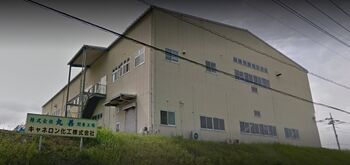
Contents
History
The history of the company can be traced back to the Meiji era[2], when Japanese entrepreneur and pioneer of the Japanese celluloid industry[14] Seijiro Nagamine[15][16] (永峰清次郎[17], Nagamine Seijiro), an Edo-style tortoiseshell craftsman[18][19] who had just started production of celluloid combs, manufactured[20][21][22] celluloid blow ball pipes known as "Fukiage balls" (吹き上げ玉, Fukiage-dama) in 1894[23][24], the first celluloid toys in the history of Japan, produced in his workshop called Nagamine Seijiro Shoten (永峰清次郎商店, lit. Seijiro Nagamine Store) established in 1884, a business that he ran with the help of his two sons Seizaburo Nagamine[11][25] (永峰誠三郎[26], Nagamine Seizaburo) and Kanematsu Nagamine[11] (永峰兼松[27][28], Nagamine Kanematsu).
Three years later in 1897[2], Gendō Tsuboi[29][30] (坪井玄道) introduced in Japan the first table tennis ball and in the next year in 1898[2] production of table tennis balls[31] begins at Seijiro Nagamine's workshop which had just began exporting celluloid blow ball pipes in that year, shipping fifty dozens[21] to Chongqing in China.
In 1911[2][23] Seijiro Nagamine invented the blow molding method of manufacturing dolls, which he patented in 1913[32][33][34] and in 1915 Nagamine's celluloid dolls manufactured with this method were ehxibited[35][15][16] for the first time outside Japan at the Panama–Pacific International Exposition held in San Francisco.
The demand for Japanese toys increased due to the outbreak of World War I a year before in 1914[2] and in June 1918[36][37] the Japan Celluloid Products Export and Trade Association (日本セルロイド製品同業組合連合会, Nihon Seruroido Seihin Dōgyō Kumiai Rengō-kai) was established with the permission of the Ministry of Agriculture and Commerce of Japan, for the purpose of conducting export inspections and eliminating defective products in the industry and Seijiro Nagamine who at the time had three large manufacturing plants in Tokyo Metropolis, located in the special wards of Chiyoda, Kōtō and Arakawa, was appointed the representative for the Tokyo region, later changing the name of the company to Nagamine Celluloid Industry Co. Ltd.[38][39][40][41][42][43] (永峰セルロイド工業株式会社[44][45], Nagamine Seruroido[46][47][48][49][50] Kogyo Kabushiki Gaisha) also known as Nagamine Chemical Industry Co., Ltd.[12][13] (株式会社永峰化成工業[51], Kabushiki Gaisha Nagamine Kasei Kogyo). Export value of celluloid toys exceeded 350 million yen in that year but after only two years in 1920[2], demand decreased substantially and orders plummeted to less than one quarter. It was also arround this time in 1920[52] that the company started trading as Chiyoda Kogyo Kaisha, Ltd[53][54][55][56] (千代田工業株式会社[26][45], Chiyoda Industry Co. Ltd.) for some time, to dissociate itself from the "infamous" Shinjinkai Nagamine Celluloid Union[57], a left-wing labour union founded in 1919 by one of its most controversial workers, the revolutionary Masanosuke Watanabe[58][59][60][61] (渡辺 政之輔, Watanabe Masanosuke), who in the summer of that year organized the first labour strikes in the history of Japan in two[62][63] of Nagamine's factories. The company returned to its former name some years later.
In 1924[2] economy recovered and both exports and domestic consumption increased and three years later in 1927 the production volume was the largest since the decline in demand four years before. This however caused a series of business difficulties with the major of them being a drop in prices.
The Japanese industry of celluloid enjoyed a decade of prosperity during the 1930s[64] with a record of billions in production and with an export value of 20 million yen in 1935[64], supplanted only by a 42 million yen export value in 1937[64].
However in 1940[64] after Europe banned imports of Japanese toys due to the outbreak of World War II, the company ceased operations until 1945[64], when despite the catastrophic impact, it managed[64] to resume production at the end of the war.
On July 18, 1949[65] Nagamine Celluloid Industry Co. Ltd. (永峰セルロイド工業株式会社) amalgamated[66] Tokyo-based trading company, Nagamine Shoji Co. Ltd[67] (永峰商事株式会社[68]), establishing branch offices in the cities of Osaka, Sendai, Takaoka and Fukuoka, adopting the name of the amalgamated company sometime later and becoming famous in the 1960s and 1970s for its line of plastic toys and dolls and mechanical tin toys (Roly Poly, Elephant Merry-Go-Round, etc) which were sold in Japan and abroad under the brand[69][70] name "Canelon" (キャネロン, Kyaneron), a trademark for articles of a non-inflammable type of rigid vinyl[71] introduced by the company in August 1953[72] (being stimulated, by the importation of polyvinyl chloride from the United States after the war, Japanese toymakers have succeeded in replacing the higly flammable celluloid, by non-inflammable plastic after painstaking research), which gained high reputation and were subsequently exported to the United States and Canada two months later in October of the same year, replacing articles of their previous trademarks "Chiyoloid"[73][74][75][76][77][78][79][80] (チヨロイド, Chiyoroido) and "Nack"[81][73][82][83] (ナック , Nakku).
Sometime in 1986, the company changed its name to Canelon Co. Ltd.[84][85] (named after its well known brand of toys), producing mostly toys for babies, including several from the Miffy series of toys for children, sold by Sega in Japan, like the Busy Gym, later manufactured and distributed exclusively by Sega Toys.
In 2002 the company was acquired by Maruzen Co. Ltd (株式会社丸善) which had been investing capital in the company since 1989, becoming Canelon Chemicals Co. Ltd. (キャネロン化工株式会社).
Promotional material
Print advertisements
Expression error: Unexpected < operator. File:The Japan Trading Guidance Book JP 1920 (by Teikoku Tsusho Kyokwai).pdf
Expression error: Unexpected < operator. File:The Indo-Japanese Business Directory 1938-1939 Book JP (by Nakaya Misuma Company Limited).pdf
Expression error: Unexpected < operator. File:Toy Catalogue JP 1985.pdfFile:Toy Catalogue JP 1985.pdfFile:Toy Catalogue JP 1985.pdf
Patents
JP40366[90]
Gallery
Nagamine's celluloid dolls, as seen in 1917[11] (Nagamine's logo in the background)
A pair of Sudare (window blinds) manufactured by the company
Old toys
External links
- Info about Maruzen Co, Ltd and its two subsidiary companies, E-Half Co, Ltd and Canelon Co, Ltd at www.foomajapan.jp
- www.maruzen.net/canelon/
- www.maruzen.net
- www.e-half.co.jp
- www.nippra.or.jp
- www.gangu-kumiai.com
- www.toyjournal.or.jp
- www.celluloidhouse.com
- www.sekiguchi.co.jp
- www.monchhichi.co.jp
- Japanese stuffed toy line of dolls "Monchhichi" manufactured by Sekiguchi Co. Ltd. at www.wikipedia.org
- Revolutionary worker Masanosuke Watanabe (渡辺 政之輔), former laborer of Nagamine Celluloid Co. Ltd at www.wikipedia.org[92][93]
- Japanese feminist and labor activist Tanno Setsu (丹野セツ), wife of Masanosuke Watanabe (渡辺 政之輔) at www.wikipedia.org[92][93]
- Japanese entrepreneur Keiji Iwakami (岩上敬二), founder of Iwakami Industry Co. Ltd. (岩上工業株式会社, Iwakami Kogyo Kabushiki Gaisha) and former employee of Nagamine Celluloid Co. Ltd. at iwakamikogyo.wixsite.com (archived)
- Legendary Japanese radio presenter and Seijiro Nagamine's (永峰清次郎) grandson, Yasuo Nagamine (永峰康雄), best known by his stage name Tatsuya Katsura (桂竜也) at ja.wikipedia.org[94]
- Japanese freelance writer Eitaro Nagamine (永峰英太郎), Yasuo Nagamine's (永峰康雄) eldest son and Seijiro Nagamine's (永峰清次郎) great grandson at gentosha-go.com (archived)[95][96][97]
- A celluloid soap box of the brand "Chiyoloid" manufactured by Nagamine Celluloid Industry Co. Ltd. in the 1930s, from the collection of the Museum of Applied Arts & Sciences of New South Wales, Australia at collection.maas.museum
- "The Repatriation of Celluloid Dolls from the USA" (アメリカ帰りのセルロイド人形), a documentary by Daicel Corporation and Tokyo-based satellite broadcasting station BS-TBS about Daicel's own roots and the birth of the Japanese celluloid industry with references to Mr. Seijiro Nagamine (永峰清次郎) at www.youtube.com[98]
- "The Repatriation of Celluloid Dolls from the USA" (アメリカ帰りのセルロイド人形), Japanese version at www.youtube.com[98]
- "The Repatriation of Celluloid Dolls from the USA" (从美国归来的赛璐珞玩偶), Chinese version at www.youtube.com[98]
- "Plastics" (1944), a film by Young America Films, Inc. surveying the growth of the plastic industry, stressing the new materials developed during World War II at archive.org
References
- ↑ File:Glimpses-of-East-Asia-Book-JP-1935-Volume-18-page-54.jpg
- ↑ 2.0 2.1 2.2 2.3 2.4 2.5 2.6 2.7 File:History of Japanese Celluloid Industry JP Part 2.pdf, page 9
- ↑ http://www.maruzen.net/canelon/index.html
- ↑ http://www.maruzen.net/index.html
- ↑ File:Da23d02a759ca3fc58eff4f28ce4c8f96b00fe61.jpg
- ↑ File:CanelonToys Box.jpg
- ↑ File:CanelonToys Doll.jpg
- ↑ File:CanelonToys Baby Toy.jpg
- ↑ File:CanelonToys Piano.jpg
- ↑ File:Japan in the Taisho Era Book JP 1917 (by Nishizawa, Iwata).pdf, page 725
- ↑ 11.0 11.1 11.2 11.3 File:Japan in the Taisho Era Book JP 1917 (by Nishizawa, Iwata).pdf, page 726
- ↑ 12.0 12.1 File:The Indo-Japanese Business Directory 1938-1939 Book JP (by Nakaya Misuma Company Limited).pdf, page 211
- ↑ 13.0 13.1 File:The Indo-Japanese Business Directory 1938-1939 Book JP (by Nakaya Misuma Company Limited).pdf, page 244
- ↑ File:TheChemistandDruggist UK 1920-06-26.pdf, page 204
- ↑ 15.0 15.1 File:Japan and Her Exhibits at the Panama-Pacific International Exhibition Book JP 1915 (by Hakurankwai Kyokwai, Tokyo).pdf, page 282
- ↑ 16.0 16.1 File:Japan and Her Exhibits at the Panama-Pacific International Exhibition Book JP 1915 (by Hakurankwai Kyokwai, Tokyo).pdf, page 466
- ↑ File:Celluloid Library Memoir House of Yokohama; Conference Osaka 2008.pdf, page 18
- ↑ http://www.manekineko-k.com/users/other/coast/blog/?p=1356 (archive.today)
- ↑ https://www.culture.city.taito.lg.jp/bunkatanbou/craft/craftsmen/english/page_08.html (archive.today)
- ↑ File:Yokohama Port and Celluloid Toys JP Research Report (by Kazuhiko Matsuo).pdf, page 6
- ↑ 21.0 21.1 21.2 File:Yokohama Port and Celluloid Toys JP Research Report (by Kazuhiko Matsuo).pdf, page 7
- ↑ http://www.celluloidhouse.com/salon35.htm (Wayback Machine: 2019-05-31 09:26)
- ↑ 23.0 23.1 File:Celluloid Library Memoir House of Yokohama; Conference Osaka 2008.pdf, page 21
- ↑ https://www.google.pt/search?q=永峰清次郎+吹上玉&hl=pt-PT&biw=1366&bih=625&tbm=bks&sxsrf=ALeKk01EqPbirL-YCYQyHn9fhs1cvC6pig:1623216618139&ei=6lHAYMT8B82mafD4nuAB&oq=永峰清次郎+吹上玉&gs_l= (archive.today)
- ↑ https://ameblo.jp/akasikogorou/entry-12833255131.html (archive.today)
- ↑ 26.0 26.1 File:Seizaburo Nagamine, Database for Japanese Studies (Eighth Edition); Human Resources Information 1928-07-03 (by Nagoya University Graduate School of Law).pdf
- ↑ http://www.celluloidhouse.com/list.htm (Wayback Machine: 2008-11-21 20:41)
- ↑ https://dl.ndl.go.jp/info:ndljp/pid/3558644?tocOpened=1 (archive.today)
- ↑ http://archive.footballjapan.co.uk/user/scripts/user/person_en.php?person_id=7 (archive.today)
- ↑ File:GendouTsuboi.jpg
- ↑ https://world-tt.com/ps_info/ps_report_detail.php?bn=5&pg=HEAD&page=BACK&rpcdno=1513#1513 (archive.today)
- ↑ File:Celluloid Library Memoir House of Yokohama; Conference Osaka 2008.pdf, page 16
- ↑ 33.0 33.1 https://jaa2100.org/entry/detail/055449.html (archive.today)
- ↑ http://www.celluloidhouse.com/salon17.htm (archive.today)
- ↑ https://www.daicel.com/news/2017/20171130_109.html (Wayback Machine: 2020-02-15 15:00)
- ↑ http://www.celluloidhouse.com/salon142.html (Wayback Machine: 2019-09-08 19:27)
- ↑ http://www.nippra.or.jp/enkaku.html (Wayback Machine: 2016-12-20 21:01)
- ↑ File:Working Rules for Financial Statements and Pre-WW2 Financial Reporting of Japanese Industrial Firms 2008-03 (by Masayoshi Noguchi and Michiyasu Nakajima).pdf, page 10
- ↑ File:Working Rules for Financial Statements and Pre-WW2 Financial Reporting of Japanese Industrial Firms 2008-03 (by Masayoshi Noguchi and Michiyasu Nakajima).pdf, page 14
- ↑ File:Working Rules for Financial Statements and Pre-WW2 Financial Reporting of Japanese Industrial Firms 2008-03 (by Masayoshi Noguchi and Michiyasu Nakajima).pdf, page 25
- ↑ File:The Japan Year Book 1920-1921 Book JP (by Yoshitaro Takenobu).pdf, page 687
- ↑ File:The Japan Year Book 1923 Book JP (by Yoshitaro Takenobu).pdf, page 656
- ↑ File:The Social Democratic Movement in Prewar Japan Book US 1966 (by George Oakley Totten).pdf, page 163
- ↑ File:801eb06276ffeb216fd73429c0dc1a3f5562cbbe.jpg
- ↑ 45.0 45.1 https://www.i-repository.net/il/meta_pub/G0000381eigyo_EIGY00762 (archive.today)
- ↑ File:Production Organizations in Japanese Economic Development Book JP 2007-01-18 (by Tetsuji Okazaki).pdf, page 190
- ↑ File:Production Organizations in Japanese Economic Development Book JP 2007-01-18 (by Tetsuji Okazaki).pdf, page 191
- ↑ File:Production Organizations in Japanese Economic Development Book JP 2007-01-18 (by Tetsuji Okazaki).pdf, page 208
- ↑ File:Production Organizations in Japanese Economic Development Book JP 2007-01-18 (by Tetsuji Okazaki).pdf, page 210
- ↑ File:List of Source Material for the Estimation of Inventory Investment (by Hermes-IR; Hitotsubashi University Repository).pdf, page 10
- ↑ File:Overview of the companies that existed in the Higashiogu district of Arakawa, Tokyo (by Tokyo Environment Bureau).pdf, page 1
- ↑ https://blog.goo.ne.jp/19471218/e/257a5402998faf7683cc178bb010996e (archive.today)
- ↑ https://books.google.pt/books?id=wAYxAQAAIAAJ&q=千代田工業,+永峰セルロイド工業&dq=千代田工業,+永峰セルロイド工業&hl=pt-PT&sa=X&ved=2ahUKEwiYzJ_6883rAhVFOBoKHbUYD30Q6AEwAnoECAEQAg (archive.today)
- ↑ File:The Japan Trading Guidance Book JP 1920 (by Teikoku Tsusho Kyokwai).pdf, page 30
- ↑ File:Merchants and Manufacturers of Tokyo and Vicinity Book JP 1922 (by Tokyo Chamber of Commerce).pdf, page 52
- ↑ File:ThePerfinsBulletin US 2007-09 (by The Perfins Club).pdf, page 9
- ↑ File:Japan'sFirstStudentRadicals Book US 1972 (by Henry DeWitt Smith II).pdf, page 97
- ↑ https://www.xwhos.com/person/masanosuke_watanabe-whois.html (archive.today)
- ↑ https://books.google.pt/books?id=k7YwDwAAQBAJ&pg=PA186&dq=earthquake+nagamine+celluloid&hl=pt-PT&sa=X&ved=2ahUKEwjVu-y8uofxAhWEzoUKHVHdDP8Q6AEwAHoECAIQAg#v=onepage&q=earthquake%20nagamine%20celluloid&f=false
- ↑ https://komatsu3.at.webry.info/201807/article_10.html (archive.today)
- ↑ https://www.amazon.com/Watanabe-masanosuke-jidai-BunzoÌ-KatoÌ/dp/4761706686 (archive.today)
- ↑ File:Japan'sFirstStudentRadicals Book US 1972 (by Henry DeWitt Smith II).pdf, page 98
- ↑ https://blog.goo.ne.jp/19471218/e/bfdb403fa1e221e695717a12ae2c4031 (archive.today)
- ↑ 64.0 64.1 64.2 64.3 64.4 64.5 File:History of Japanese Celluloid Industry JP Part 2.pdf, page 10
- ↑ File:OfficialGazetteofJapan JP 1949-09-24 (English Edition; Government Printing Agency).pdf, page 25
- ↑ File:OfficialGazetteofJapan JP 1949-11-25 (English Edition; Government Printing Agency).pdf, page 12
- ↑ File:Commercial Import Detentions Report 1971-1972 (United States Department of Health, Education and Welfare; Food and Drug Administration).pdf, page 379
- ↑ File:Canelon JP PrintAdvert.jpg
- ↑ File:Agriculture Environmental and Consumer Protection for Fiscal Year 1972 (United States Senate; Committee on Appropriations).pdf, page 150
- ↑ File:ConsumerNews US Volumes 1-3 (United States Office of Consumer Affairs).pdf, page 67
- ↑ File:B1d2415e0b1a201e095bc992eb7f71e6e8098eae.jpg
- ↑ https://www.google.pt/search?q=In+August+1953+Nagamine+Celluloid+Kogyo+K.K.&biw=1366&bih=625&tbm=bks&sxsrf=ALeKk00oYpGJkz0l8Mb19ajS7eCEYLIiig:1623134365924&ei=nRC_YLXuN8ykaa6Mq9gB&oq=In+August+1953+Nagamine+Celluloid+Kogyo+K.K.&gs_l= (archive.today)
- ↑ 73.0 73.1 File:C501b229a545ecf15a4960c3a5a57344ede22b12.jpg
- ↑ File:D005d2779e0e9812a248a22bfd6b68a281ab8929.jpg
- ↑ https://auctions.morphyauctions.com/EARLY_PRE_WAR_JAPANESE_CELLULOID_WIND_UP_CHEF_TOY_-LOT503004.aspx (archive.today)
- ↑ File:MorphyAuctions US Catalogue 2021-06.pdf, page 86
- ↑ https://www.worthpoint.com/worthopedia/celluloid-santa-original-box-vintage-japan (Wayback Machine: 2021-06-03 19:10)
- ↑ File:69fce9144dbd0048082ffa462ba8ce5025b5529a.jpg
- ↑ File:Chiyoloid-JP-Bicycle-Hand-Grip-Set.jpg
- ↑ File:Chiyoloid-Poly-Gorand-Celluloid-Wind-Up-Toy.jpg
- ↑ File:Abdd2a3eba5e827fa96aebe0f3acb5c20c9bfb69.jpg
- ↑ File:Nack Celluloid Kewpie Style Baby Doll.jpg
- ↑ https://www.gumtree.com.au/s-ad/nailsworth/collectables/rare-large-vintage-mid-century-celluloid-kewpie-style-baby-doll/1309761858 (Wayback Machine: 2023-06-07 14:34)
- ↑ https://www.google.pt/search?q=chiyoloid&sxsrf=ALeKk03_Ivvic42075vD1xTkEzQ3yMUHOg:1622675480900&source=lnms&tbm=bks&sa=X&ved=2ahUKEwis_P6cifrwAhVFwAIHHWmHA9EQ_AUoAXoECAEQCw&biw=1366&bih=625 (archive.today)
- ↑ File:Japan-Directory-JP-1986-page-113-by-Japan-Press.png
- ↑ https://jaa2100.org/entry/detail/056799.html (archive.today)
- ↑ @dokemono on Twitter (archive.today)
- ↑ https://www.grandoldtoys.com/toydb_Detail.php?id=775&S_keywords=celluloid,bird,japan&Search.x=0&Search.y=0 (archive.today)
- ↑ 89.0 89.1 http://skullbrain.org/bb/index.php?threads/revenge-of-the-retro-japanese-toy-adverts.48572/page-24 (archive.today)
- ↑ File:ChemicalAbstracts US 10 (Vol. 17) 1923-05-20 (by American Chemical Society).pdf, page 153
- ↑ http://aiterasu.net/prof.html (archive.today)
- ↑ 92.0 92.1 http://gendainoriron.jp/vol.18/column/col04.php (archive.today)
- ↑ 93.0 93.1 http://gendainoriron.jp/vol.21/column/obata.php (archive.today)
- ↑ File:E84bd00973aa2eabf84125f43dd57bea2000e042.jpg
- ↑ File:B941a16502ab371f2f3d71ec32bb40b2f1d41a29.jpg
- ↑ @dokemono on Twitter (archive.today)
- ↑ http://www.repo-zine.com/201103vol3.html (archive.today)
- ↑ 98.0 98.1 98.2 File:The Repatriation of Celluloid Dolls from the USA Documentary JP Promotional Poster.pdf
